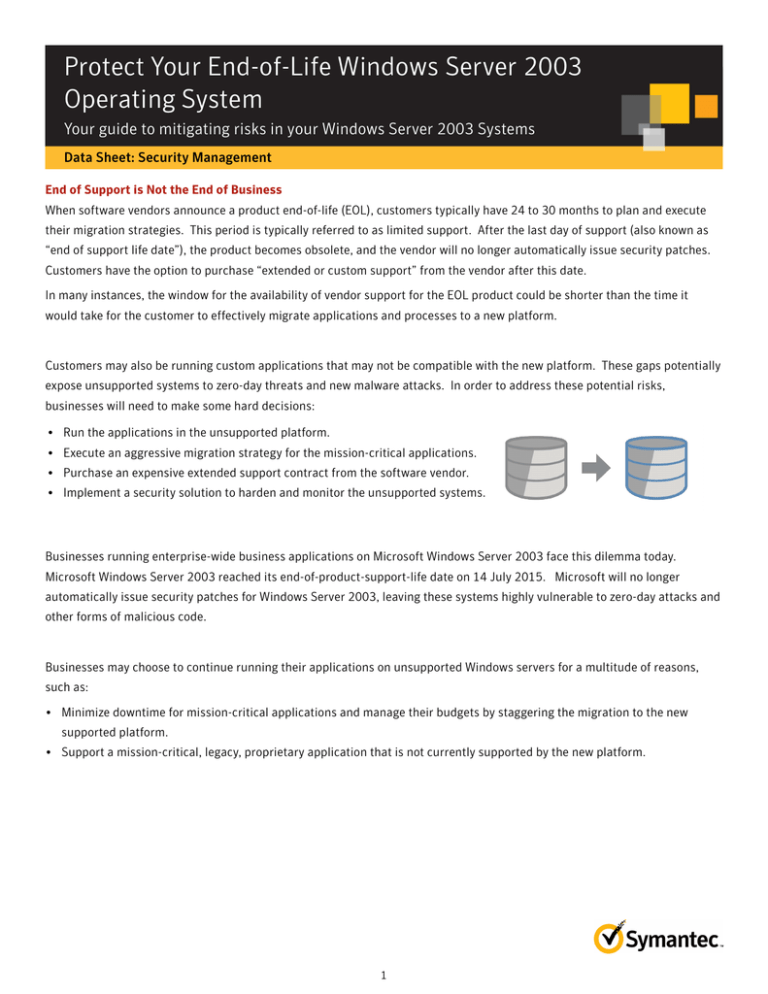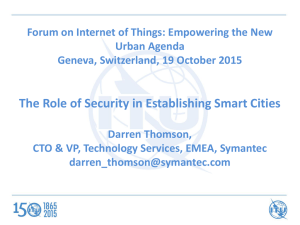
Protect Your End-of-Life Windows Server 2003
Operating System
Your guide to mitigating risks in your Windows Server 2003 Systems
Data Sheet: Security Management
End of Support is Not the End of Business
When software vendors announce a product end-of-life (EOL), customers typically have 24 to 30 months to plan and execute
their migration strategies. This period is typically referred to as limited support. After the last day of support (also known as
“end of support life date”), the product becomes obsolete, and the vendor will no longer automatically issue security patches.
Customers have the option to purchase “extended or custom support” from the vendor after this date.
In many instances, the window for the availability of vendor support for the EOL product could be shorter than the time it
would take for the customer to effectively migrate applications and processes to a new platform.
Customers may also be running custom applications that may not be compatible with the new platform. These gaps potentially
expose unsupported systems to zero-day threats and new malware attacks. In order to address these potential risks,
businesses will need to make some hard decisions:
• Run the applications in the unsupported platform.
• Execute an aggressive migration strategy for the mission-critical applications.
• Purchase an expensive extended support contract from the software vendor.
• Implement a security solution to harden and monitor the unsupported systems.
Businesses running enterprise-wide business applications on Microsoft Windows Server 2003 face this dilemma today.
Microsoft Windows Server 2003 reached its end-of-product-support-life date on 14 July 2015. Microsoft will no longer
automatically issue security patches for Windows Server 2003, leaving these systems highly vulnerable to zero-day attacks and
other forms of malicious code.
Businesses may choose to continue running their applications on unsupported Windows servers for a multitude of reasons,
such as:
• Minimize downtime for mission-critical applications and manage their budgets by staggering the migration to the new
supported platform.
• Support a mission-critical, legacy, proprietary application that is not currently supported by the new platform.
1
Data Sheet: Security Management
Protect Your End-of-Life Windows Server 2003 Operating System
Challenges of Legacy Systems
The following security and compliance issues influence how businesses will execute their Windows Server 2003 EOL migration
and risk mitigation strategies:
1) Securit
Securityy threats from zzero-da
ero-dayy vulnerabilities and sophis
sophisticated
ticated malware
Security researchers continue to find new vulnerabilities in out-of-support operating systems (OS),
which malicious entities are very eager to exploit.
Malicious hackers have been known to target unsupported systems as a method for gaining entry into a
business’s IT infrastructure. As large enterprises beef up their security protection, hackers are also using
the unsupported systems in a large enterprise’s supply chain ecosystem to gain entry.
2) Re
Regulator
gulatoryy compliance and ccyber
yber securit
securityy governance
Regulations like PCI-DSS and HIPAA-HITECH demand businesses take the necessary precautions to
protect information and processes running on potentially vulnerable systems.
The Securities and Exchange Commission (SEC) has been very vocal in issuing guidelines and obligations
for reporting on data breaches. In its January 2014 Priorities letter, the SEC’s Office of Compliance
Inspections and Examinations (OCIE) included governance and supervision of information technology
systems, operational capability, market access, information security, and preparedness to respond to
sudden malfunctions and system outages.
Cyber security is now considered a primary risk factor and company annual reports must now reflect
this. Running unprotected systems, therefore, exposes the business to compliance violations, resulting in
hefty fines, sanctions and penalties.
3) Reputation damage and remediation co
cosst associated with data breach
Unprotected systems makes the business more susceptible to data breaches, loss of critical,
confidential data, and business disruption such as an inability to run mission-critical transactions or
deliver customer services—all of which damage the brand and the customer’s trust. On top of that,
businesses will incur the costs associated with system remediation, investigation, and customer care
following the attack.
4) Co
Cossts associated with tes
testing
ting and vvalidating
alidating “cus
“custom
tom”” Micro
Microsof
softt patches
Customers also have to consider the investment to test and validate patches to the business
applications running on top of the legacy servers. Even if the customer purchases patches from
Microsoft, most application vendors won’t support the patches as they cannot test that the patch will
not impact their application. The onus on testing and validating the Microsoft custom patches rests on
the customer. The customer will also have to assume the risks of application outages resulting from
incompatibility with the patch. This leads to increased operational cost and risks.
What Options Are There?
Customers have four options for addressing their potential security exposure from running unsupported Windows Server 2003
systems after its last day of support:
2
Data Sheet: Security Management
Protect Your End-of-Life Windows Server 2003 Operating System
Op
Option
tion 1: Do nothing. Some customers may choose to continue running applications on the unsupported platform when these
applications are not considered as mission critical. Recent data breaches have shown that malicious hackers are taking
advantage of vulnerabilities in unsupported systems to gain a backdoor entry for launching their attacks.
Doing nothing is not an option when the applications are mission critical but not compatible with the new platform. In this
instance, customers will need to decide between executing an aggressive platform migration, purchasing a Customer Support
Agreement, or enabling a server security hardening solution.
Op
Option
tion 2: Migrate applications into the new Windows Server Systems platform. This option is most suitable for taking
advantage of the benefits of a new OS and its associated applications, or for minimizing the operational and management costs
of IT systems by standardizing its hardware and software. Customers will be able to eliminate the risks and vulnerabilities
associated with end-of-life systems.
Even though a migration can eventually lead to significant productivity, security and control benefits, it can still be an
intimidating task. In the past, migrations involved manually collecting inventory and configuration data, throwing together
solutions from disparate tools, writing and testing scripts to handle endless contingencies and dependencies, plus a thousand
other endless routines that exhausts time, energy, money, motivation and executive patience.
Customers planning their platform migrations also need to take into account the impact an aggressive migration strategy
would have on their operational budgets.
Op
Option
tion 3: Purchase “Custom Support Agreements (CSA)” from Microsoft. There are several critical issues to consider for
customers evaluating this option:
• Only customers with a Premier Support Contract are eligible to purchase a CSA.
• Based on recent customer discussions, quotes can range from $500 to $750 per server.
• Access to “custom support” for legacy platforms like Windows Server 2003 are not distributed automatically.
• Even if Microsoft rates a vulnerability at the highest critical level, Microsoft will commit to a patch but there are no strict
SLAs for the responsiveness to deliver this patch. Other incidents not deemed as critical by Microsoft may or may not be
fixed, but workarounds and suggestions may be given. This means that zero-day vulnerabilities remain unaddressed,
opening systems to attack during instances of patch unavailability and other windows of exposure.
• CSAs are approved at a high management level within Microsoft on a case by case basis. The costs are not just the support
fees – lengthy legal negotiations and approvals can be required for large
corporations and this has to be taken into account.
• This option is not intended to be a long-term solution as “custom support” programs are specifically designed to help
customers bridge the support gap as they migrate to new operating systems.
• This option also incurs a higher cost due to costly “custom support” and frequent testing and
deployment of patches.
3
Data Sheet: Security Management
Protect Your End-of-Life Windows Server 2003 Operating System
Op
Option
tion 4: Protect, Monitor, and Harden your legacy systems with Server Hardening Solutions.
With this approach, the customer deploys HIPS/HIDS based security to harden the servers, monitor for
any activities in the application and OS kernels, and lock down admin rights and access to applications.
This option will enable customers the ability to execute a server refresh and migration plan that fits
their operational and budget objectives, and still protect their server infrastructure. Customers can
minimize downtime and protect applications that are not currently compatible with the new OS
platform.
Benefits of this approach:
• Improves the security posture of your servers by protecting them against known and unknown (zero-day) malware.
• Eliminates emergency patching, and minimizes downtime and IT expenses related to patching through proactive protection
that does not require continuous updates.
• Reduces security incidents and remediation costs with continuous protection even if the server is
unable to get the latest patches in a timely fashion.
Option 4 clearly provides the best choice, with better and more consistent host security, lower overall costs and more control
with regards to legacy system replacement.
Symantec Data Center Security
Symantec Data Center Security: Server Advanced will help customers secure their Windows Server 2003 and other legacy
systems effectively, so they can:
• Minimize downtime and business disruption
• Execute a platform migration plan that fits their operational and budget constraints
• Maintain compliance to security standards and fulfill regulatory obligations.
• Automate and orchestrate a microsegmentation strategy, thus applying security hardening policies at the application-level
instead of relying on rigid network and security zones. This “application-level” security approach provides an additional
layer of protection for mission-critical applications in the event a Windows Server 2003 system is compromised.
Symantec Data Center Security: Server Advanced offers the following features to protect the customers’ legacy Windows Server
2003 systems:
For more information on Symantec Data Center Security: Server Advanced, download the Symantec Data Center Security:
Server Advanced data sheet. As with any migration, the challenge is to execute it in an efficient, cost-effective, and sustainable
4
Data Sheet: Security Management
Protect Your End-of-Life Windows Server 2003 Operating System
manner while protecting end-user productivity. Symantec can meet that challenge with migration and deployment solutions
that streamline processes to cut the expense, delay, and disruption of migration, keeping it in control.
Secure or migrate with S
Symantec
ymantec toda
todayy.
The challenges of running unsupported legacy systems are not insignificant. But they are not insurmountable either. Just
because OS support has ended does not necessarily mean businesses are left vulnerable to security threats or at the mercy of
costly end-of-life support.
Symantec’s solutions offer simplified, comprehensive and cost-effective protection and migration of Windows Server 2003
systems. Business operations continue uninterrupted and industry compliance regulations are still met. Companies also gain
control and set the pace of system migration based on their business needs and schedule.
For more information on securing your legacy systems, visit us.
More Information
Visit our website
http://enterprise.symantec.com
To speak with a Product Specialist in the U.S.
Call toll-free 1 (800) 745 6054
To speak with a Product Specialist outside the U.S.
For specific country offices and contact numbers, please visit our website.
About Symantec
Symantec Corporation (NASDAQ: SYMC) is an information protection expert that helps people, businesses, and governments
seeking the freedom to unlock the opportunities technology brings—anytime, anywhere. Founded in April 1982, Symantec, a
Fortune 500 company operating one of the largest global data intelligence networks, has provided leading security, backup,
and availability solutions for where vital information is stored, accessed, and shared. The company's more than 20,000
employees reside in more than 50 countries. Ninety-nine percent of Fortune 500 companies are Symantec customers. In fiscal
2014, it recorded revenue of $6.7 billion. To learn more go to www.symantec.com or connect with Symantec at:
go.symantec.com/socialmedia.
Symantec World Headquarters
350 Ellis St.
Mountain View, CA 94043 USA
+1 (650) 527 8000
1 (800) 721 3934
www.symantec.com
Copyright © 2015 Symantec Corporation. All rights reserved. Symantec, the Symantec Logo, and the Checkmark Logo are trademarks or registered trademarks of Symantec Corporation or its affiliates in the U.S.
and other countries. Other names may be trademarks of their respective owners.
21345142-1 08/15
5

